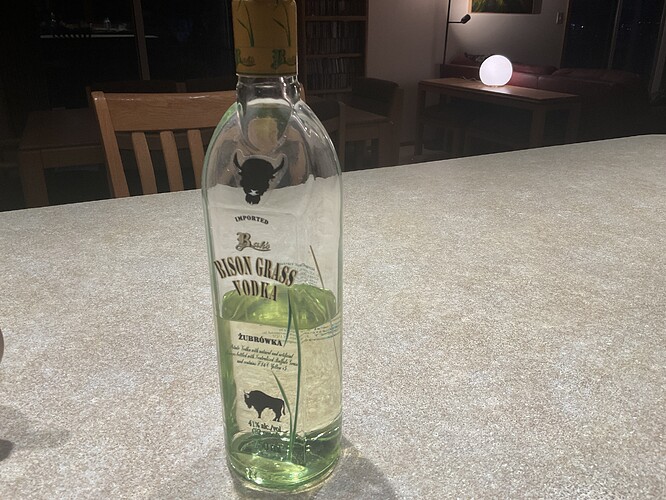I have a bottle of genepi that came with a sprig of artemisia inside. I felt like the taste of the spirit changed once the fill level lowered to expose some of the sprig to the air. Do you think the oxidizing plant material could create off flavors? Should it be removed once the bottle is opened? Or am I not recalling the original taste correctly? Must solve, antique millefiori awaits….
Interesting question. Seems likely. I immediately thought of Zubrowka—I’m out of stock—but the leaf in that bottle is almost negligible it is so wispy.
Your Zubrowka comment prompted me to pull out my own bottle, untouched in probably 20 years! Looks exactly the same as it did when I got it after reading Somerset Maugham’s THE RAZOR’S EDGE, in which it’s prominently featured. I’m not sure why as much is gone as is, since I’m not a vodka enthusiast, but I must have done something with it back then.
The wisp of grass is just as it was— and that’s with half of it sticking out of the half-bottle’s worth of vodka. I don’t recall ever having read the label, which is now fascinating, and a bit unnerving. Here’s the text, with the capitalizations and lack of punctuation preserved perfectly (like the wisp of grass!):
Potato Vodka with natural and artificial flavors bottled with Neutralized Buffalo Grass and contains FD&C Yellow #5
I’m wondering what the artificial flavor is…artificial Buffalo flavor, perhaps? ![]() It’s a very appealing pale greenish-yellow, like a vinho verde, courtesy of that Yellow #5.
It’s a very appealing pale greenish-yellow, like a vinho verde, courtesy of that Yellow #5.
I’m not into vodka, either, but Zubrowka is delicious. Looks like the one you have is the version modified to pass FDA requirements (coumarin-free). I’m not sure whether that’s even still available in the USA—haven’t spotted any in a while.
Thanks for the push down the coumarin rabbit-hole! I’d seen the word at some point/s in my life, but I think I had it confused with whatever blood thinner they give people who’ve had strokes etc.— and now I see that TONKA BEAN is the main source of this chemical. That’s something I’ve been aware of as an ingredient in perfumery, generally to give a vanilla-like note. Fun to see the list of other flora which contain trace amounts of it, including (per Zubrowka) bison grass!
The best thing about this article, though, is the comment about odds of toxicity from consumption of coumarin as commonly used, i.e. that you’d need to eat so many tonka bean desserts in a day to get there that liver toxicity would be the least of your concerns!
I’ll give my ancient bottle a try later today, with special attention to any vanilla-esque note.
(You can see the wisp of the grass, parallel to the illustration of a more robust example)
I’m dragging myself away from the internet after sending this…but I think others (or maybe just YOU, Martin) may be intrigued to see that the bison grass of Poland is directly related to the sweetgrass of N. America. The native people here don’t use it to flavor vodka, though!
I see there are those who are convinced bison grass/sweetgrass is the “oldest organism in the world,” but that seems a bit unprovable. I like the idea, though.
My girlfriend is a conservation specialist at the National Museum of Natural History in France. One of her many tasks is monitoring the wet specimen collections (some hundreds of years old). Everything organic, such as animals, plants and insects, if not dried, is preserved in jars under 75% ethanol. Ethanol being ethanol, it evaporates over decades. When this happens, it needs to be topped up and anything exposed to air (often dozens or hundreds in the same jar for small specimens) needs to be evaluated to decide if it can be safely kept or needs to be discarded. They have 3 freaking square kilometers of storage (think last scene of Indiana Jones) and sometimes she is the first person to have opened a jar in 100 years. Still, they don’t discard a great deal, and mostly because a specimen has overly dried and can’t be rehydrated by new ethanol.
Not sure how much this would apply to the shorter lifetime of bottles of liquor. I would imagine that there could be some degradation if the plant material is out of the alcohol, but honestly, anything lower than 70-75% ethanol isn’t really that great for preserving organic matter anyway. If exposed for a long time, I’d toss it. Any positive flavor benefit of the material has long since been achieved and it’s probably just ornament.
[side note] Ethanol being ethanol, it also has a tendency over the decades and centuries of drawing out any soluble compounds from the specimens, requiring this cloudy and dark infusion to be completely replaced with fresh. Any of this ethanol that is removed from the bottles there is discarded. Seems like such a shame. That’s a potential 3 square km of racks and drawers and shelves of 100-year-old scorpion, snake, octopi and other bitters! Alas… she has yet to be convinced.
